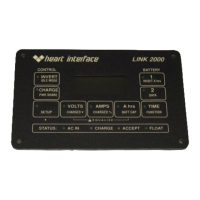5/31/96
3
INTRODUCTION AND SPECIAL NOTES
Congratulations! You have purchased a powerful instrumentation and control system. In
order to understand, use, and install it, PLEASE read this manual!! It is as short as possible
and provides important information. Please contact us with suggested improvements. For
installation and operation questions please call Heart Interface. For warranty support and
repair please call Cruising Equipment.
The following Important Special Notes contain cautions and special considerations that must be
considered during the installation of the LINK 2000. Failure to read and follow these special
notes can lead to damage of the LINK 2000, the inverter, or other electrical equipment.
The Helping Hand is used to draw your attention to very important sections of this manual
or to indicate items that may need to be changed through the SET UP routine. Please take the
time to read these sections.
1) DO NOT DISCONNECT THE NEGATIVE BATTERY CABLE TO THE FREE-
DOM WITH THE INVERTER OR CHARGER TURNED ON! WHEN INSTALLING,
CONNECT THE INVERTER CABLES
BEFORE PLUGGING THE PHONE CORD
INTO THE LINK-2000. UNPLUG THE PHONE CORD BEFORE THE FREEDOM
IS DISCONNECTED FROM THE BATTERY.
2) Turn the ON/OFF switch located on the inverter to the off position must be OFF.
3) When used in a mixed voltage (12V & 24V) system, Battery #1 is the battery that the LINK
uses for voltage regulation. Make sure it is the battery that is used by the Inverter/Charger, or
with the LINK 2000-R option it must be the battery being charged by the alternator. See Functions
Mode F11.
4) All warranty issues must be resolved through Heart Interface
or Cruising Equipment Co.. Please do not return to, or route warranty
issues through, the retailer, dealer, or installer.
BASIC BATTERY FACTS
1) An Amp-hour is 1 Amp for one hour, or 2 Amps for 1/2 hour, or 4 Amps for 1/4 hour,
etc.
2) Batteries for cycling service are normally rated with a 20 hour rate which means a 100
A hr battery will sustain 5 amps for 20 hours.
3) Our Mid-Capacity Rule says that discharge below 50% shortens battery life and
charging more than 85% takes too long with an engine driven charging system. So, 35%
of the battery capacity is all that is normally available.

